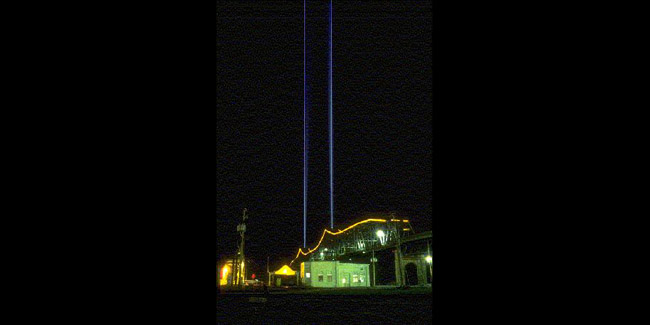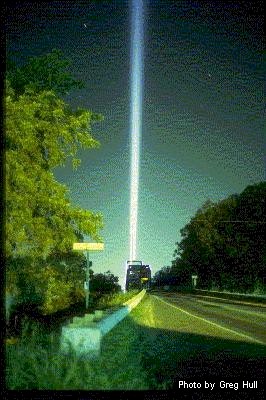|
-
-
- Amelia’s
Gate © 1997
-
- Amelia Earhart Memorial
- Missouri River Bridge Project,
Atchison, Kansas
-
ARTISTS STATEMENT
"Amelia’s Gate" was a
sculptural memorial to Amelia Earhart that also serves as a gateway to the city
of Atchison, Kansas. First illuminated on the 100th anniversary of her
birth, the work uses the physical qualities of light to create a bold, thoughtful mark on
the landscape of the Aviator’s youth. The work draws its form from the dynamic
elegance of the individual it memorializes while paying homage to those rare qualities
that still inspire us all. |
|
| |
| The
sculpture used the renamed Amelia Earhart Memorial Bridge as its physical and
metaphoric armature. Beacons set at the peaks of the
bridge cast two columns of light 10,000 feet into the night sky. The scale and verticality
of the twin pillars are almost unfathomable from the ground. Accompanying the
beacons are two 1400 foot courses of fiber optic cable. They create an appropriately
scaled base for the columns of light while reiterating the elegant curves of the 1930's
bridge. This sweeping wing or bow-like form chases the structure’s curvilinear
profile with two lines of deep blue. The simple graceful lines of the work provide
the necessary degree of subtlety to temper the sculpture’s considerable scale.
The enduring pillars of light are visible from more than 20 miles. Every night they
marked the location of the city, discretely nestled between the bluffs and forests of the
area and serve as a visual point of reference for pilots in the thick night sky. From the air, "Amelia’s Gate" created an inviting physical threshold. The vertical columns of light stand alone in an
environment in which even the tallest hills and structures fall away to the horizontal
plane. The beacons provided a physical connection between the ground and the pilot's
world aloft. They speak of the flyer’s delicate position within this vast
environment and remind us that flight |
 |
| remains a precarious compromise with gravity. The decision to make
contact with one of the almost rigid columns of light momentarily saturates the cockpit.
However, by flying carefully between the pillars, the true nature of the sculpture
is revealed. As pilots passed through Amelia’s Gate, time appeared to slow as this
aerial threshold offered a uniquely somber and reflective pilgrimage. In this
respect, the memorial existed between 1000 and 10,000 feet above the earth. |
| The
interplay of aircraft, like moths to a light, ultimately lends itself to the experience of
the earth-bound viewer. Fuselages and wings become another physical aspect of the
work reminding us of the curious and inquisitive nature that first drew pilots to
flight. Here the work honors the life and spirit of Amelia Earhart. It
celebrates the connection between the city, whose history helped shape the adventurous
youth, and the aviator whose inspirational impact continues to touch the imagination of
the world. Amelia’s Gate resided in the river valley that unfolds outside the bedroom
window in which this remarkable individual was born. It climbs to the sky from just below
the bluffs where Amelia Earhart first watched hawks soar on the wind.
During the fall of 1998, the second
phase of the installation was completed. Each of the light sources for the fiber
optic cable was outfitted with a motorized, four color wheel. With the change of
each season, the fiber optic cable took on a new hue. The colors of the fiber optic
cable cycle through red, amber, green and the original deep blue. |
 |
|
| The city of Atchison , Kansas has a long rich history of exploration,
travel and commerce all revolving around crossing the river and entering the unknown
arenas that lay beyond. The Mo-Kan bridge, as it was originally named, had been a
dynamic visual element of the city for 60 years. It crossed the Missouri River,
connecting the States of Kansas and Missouri. This remarkable steel span was
completed in 1938 and was dedicated by then-Senator Harry S. Truman. It is
approximately 2600 feet in length with twin peaks that rise 140 feet above the water.
This bridge which would ultimately support the sculptural memorial, was renamed the
Amelia Earhart Memorial Bridge in 1997. Greg Hull
Contact
Back to Public Art
Back
to Main Page
|

